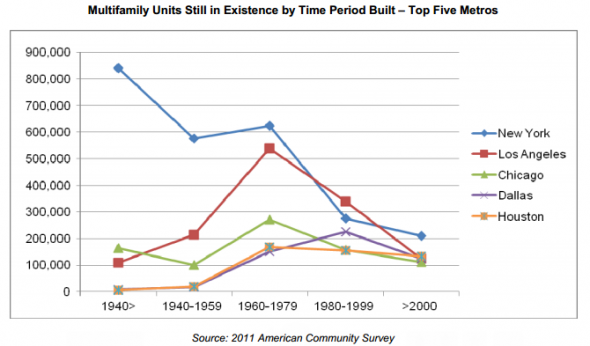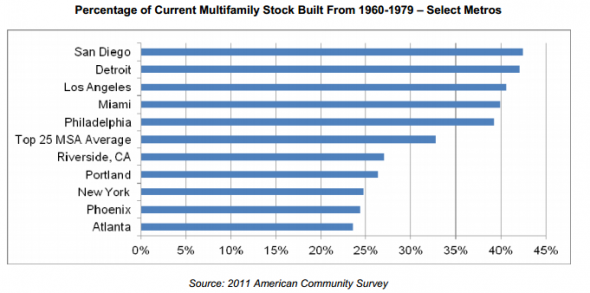Multi-family development has steadily grown to reach today’s pre-crash average of 330,000 units each year. Coupled with America’s slowest population growth in 70 years, the time seems ripe for the renewal of the nation’s multi-family housing stock. That, however, is not the case. In fact, the U.S. could soon face an apartment shortage due to the aging of the existing multi-family rental stock.
While development is booming in some large metros, this mostly accommodates migration trends to large urban centers. New projects tend to concentrate on the high-end market, and typically does not replenish moderate-income housing removed from the stock due to obsolesce.
According to the Census Bureau’s 2012 American Community Survey, close to 60 percent of America’s rental properties with 20 or more units were built before 1980. Additionally, over 50 percent of affordable to extremely low-income units are upwards of 50 years old.
Extremely low-income households are up to three times more likely to live in structurally deficient units. Last year, 13.7 percent of low-income units failed to meet the criteria for adequacy defined by the American Housing Survey, according to the State of the Nation’s Housing report by JCHS. The number of units removed from available housing inventory ranges between 5-12 percent each year, depending on market class. With over 50 percent of renters currently rent-burdened, losing more low-income housing stock worsens an existing problem.
The prevalence of aged housing stock however, is far from restricted to only low-income rentals. It is also not limited to one specific geographic area. Although different areas had different rental housing development timelines, a recent Fannie Mae report shows that while apartment stock did grow during the 1940s and 1950s, it was the late 1960s and the 1970s that apartment development grew to rates that continue to affect today’s rental housing stock and the industry itself.
The biggest apartment construction boom occurred in the early 1970s, NMHC reports, due to a collision of factors. The first wave of Baby Boomers reached adulthood, a strong economy prevailed, government urban renewal projects began, and easy credit was available. The 1986 Tax reform Act increased home mortgage interest rate deductions and negatively impacted rental development, but certain areas continued to grow their stock.
In the south and southwest, Dallas, Phoenix and Riverside, Calif., built over 40 percent of their housing stock between 1980 and 1999, while San Diego, Detroit and Miami experienced about the same growth two decades earlier. Some Sunbelt states did enjoy high rates of development between 2000 and 2011, with Phoenix, Dallas, Houston and Atlanta going over the 20 percent mark and San Antonio hitting a whopping 32 percent. But every state has some amount of aging housing stock that isn’t being replaced.
Some metros stand out with pre-war communities. Four surpass the 20 percent mark: San Francisco, New York, Chicago, and Boston. Due to good upkeep, professional tenant bases and highly desirable locations, they are designated Class A, while most old stock is considered low-grade.
The aging multi-family rental stock goes beyond dilapidated structures. It has the potential to further exacerbate the nation’s predicted apartment housing shortage. According to the 2014 State of the Nation’s Housing report by the Joint Center on Housing Studies of Harvard University (JCHS), demographic forces alone could increase the number of renter households by 4 to 4.7 million by 2023.
Based on the last few quarters’ starts, the next ten years will bring 3.1 million new units on the market. This disparity alone could lead to a multi-family rental shortage of 0.9 to 1.6 million, stemming from demographic drivers such as the sheer number of Millennials going into and Boomers returning to the rental market, an increase in the median age for marriage and immigration trends.
Income stresses across generations, especially in the wake of the Great Recession, have forced a large number of former homeowners (be it by choice or due to foreclosures) into the rental market. The growing disparity between income growth and home prices, accelerated urban core growth and the popularity for a dynamic lifestyle, untethered by a mortgage are all contributing to an ever growing need for rental supply, which in itself is far from covered by new development.
Freddie Mac reports that some estimates have already identified a 1.5 million unit shortage in the rental housing market, which is driving up rent rates. Fast-tracked rent growth coupled with stagnating job and wage growth are decreasing housing affordability across the U.S. in a time when over 50 percent of renters are reported to be rent-burdened.
To avoid a housing crisis, renovation and rehabilitation of old housing stock is imperative, as it is a more cost- and time-efficient solution to a rental housing shortage. Outdated apartments need to be updated to modern standards of safety and lifestyle, all the while keeping in mind that the two big players in the near future’s rental market will be the tech-savvy and green-conscious Millennials and the aging, ready-to-downsize Baby Boomers.





